
Gettysburg National Military Park in Pennsylvania preserves the site of the largest battle ever fought in North America and the turning point of the U.S. Civil War. The battle involved more than 160,000 troops and marked the end of General Robert E. Lee’s excursion into the North. The park surrounds the small town of Gettysburg, PA and contains most of the battlefields and positions that were key to the three-day battle fought between the 1st and 3rd of July, 1863.
Visitor Rating (write your own review below)
ILNP Park Review
Our Weather Partly cloudy skies but 85 degrees and humid.
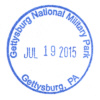 Our Visit I visited Gettysburg as part of a field trip for a course I was taking in Washington, D.C. in July, the same month the battle was fought.
Our Visit I visited Gettysburg as part of a field trip for a course I was taking in Washington, D.C. in July, the same month the battle was fought.
Overall Impression Gettysburg is a solemn place, part park, part memorial, part cemetery. Wherever you turn, you’ll see memorials to units and men who fought in this epic battle where each side suffered around 50,000 casualties. The Union victory and the stop of Lee’s advance into the north is considered the turning point of the American Civil War. The area the park covers is massive, but it’s very accessible via roads and paths, and thanks to careful management, it’s preserved well enough to easily envision every major fight in the three-day battle. Gettysburg is a “must see” not only for history buffs, but for any American because of its significance in the preservation of the Union.
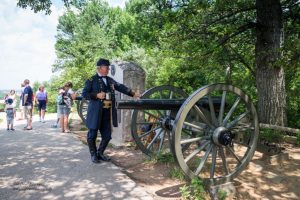
A volunteer dressed as a Union Brigadier General stands with a cannon on Little Round Top, site of fierce fighting on Day 2 of the battle.
Visiting Visiting Gettysburg will easily take a full day, and it would take several days to see everything. In a day, you can tour the major portions of the battlefield by car and take a few hikes. There are plenty of resources for a self-guided tour, but I recommend checking into a tour with a licensed guide as these pros can add much more detail and depth to what you’re seeing. The Visitors Center is a great place to start, but unless you have multiple days to visit, save the museum and cyclorama for after the battlefield tour. It helps to tour the battlefield in the basic order of the battle. Day 1 sites include McPherson’s Ridge, Oak Hill and Oak Ridge. Day 2 sites include Pitzer’s Wood, Devil’s Den, Little Round Top and Cemetery Hill. Day 3 sites include Culps Hill, Seminary Ridge, and the Angle.
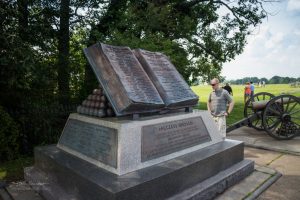
One memorial near the Angle is this one commemorating the High Water Mark of the Confederacy. This spot near the Copse of Trees is as far as the Confederates got during Pickett’s charge on the last day of the battle. After this, the Conferacy lost ground for the rest of the war.
If you have limited time, I recommend you spend it at Little Round Top and the Angle. These areas, particularly Little Round Top, were home to some of the fiercest fighting and showcase the impact topography had on the battle. Park management has done a good job in preserving the battlefields as close to possible to their condition in 1863 including trees, fences and buildings, so you really get a sense of what the soldiers saw and faced. You can also visit the national cemetery and the site of President Lincoln’s Gettysburg Address, given in November, 1863, several months after the battle.
One thing that will surprise new visitors is the sheer number of monuments strewn about the battlefield. There are more than 1300 monuments to people, events and units, and while at first they can be distracting, each tells a bit of the Gettysburg story. Take some time to read the words on the monuments you pass. If you have limited time, I recommend you spend it at Little Round Top and the Angle. These areas, particularly Little Round Top, were home to some of the fiercest fighting and showcase the impact topography had on the battle. Park management has done a good job in preserving the battlefields as close to possible to their condition in 1863 including trees, fences and buildings, so you really get a sense of what the soldiers saw and faced. You can also visit the national cemetery and the site of President Lincoln’s Gettysburg Address, given in November, 1863, several months after the battle.
Here are a few tidbits on different areas of the park and what you can expect to see. After the visitors center, they are arranged in roughly the order of the battle.
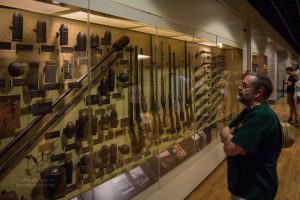
One of several displays of small arms and equipment at the Gettysburg NMP Visitors Center.
Visitors Center and Museum
The Visitors Center is impressive and boasts a large gift shop and cafeteria in addition to a museum and cyclorama which require tickets (the rest of the park is free). The facility is modern, clean and air conditioned, and is a good respite from the outdoors. There are displays of weapons and uniforms in the free area with more to see behind the doors of the paid portion of the museum.
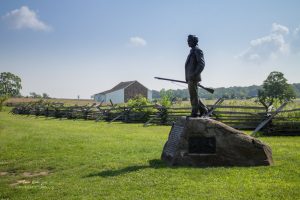
Statue to John Burns near the McPherson farm. The 70-year-old Burns, a resident of Gettysburg, brought out his musket and fought alongside Union troops.
McPherson’s Ridge
McPherson’s Ridge was the sight of the first skirmishes on Day 1 of the battle. Confederate troops were advancing toward Gettysburg from the west, as legend would have it in search of shoes, when they ran into Union cavalry and infantry which had recently arrived from the south. The Union lines initially repelled the attack. McPherson’s barn still stands, along with the fences, trees and small ridges that gave the defenders an advantage. Budget 20-60 minutes to drive through the area and stop a few of the monuments.
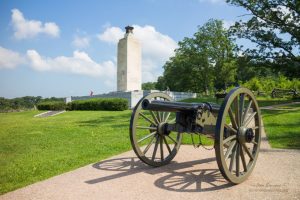
Eternal Light Peace Memorial and a small cannon atop Oak Hill overlooking the battlefield at Oak Ridge.
Oak Ridge
Fighting on Day 1 moved north from McPherson’s Ridge to Oak Ridge and the Railroad Cut where fierce fighting eventually pushed the Union defenders back through town, thanks in part to Confederate artillery which exited the woods to the north at Oak Hill along the Union flank. The large Eternal Light Peace Memorial, dedicated at the 1938 Gettysburg Reunion, now sits atop the hill. From Oak Ridge, Union forces retreated through the fields to the east and eventually took up defensive positions south of town including Cemetery Hill and Culps Hill. 30 minutes.
Seminary Ridge
Seminary Ridge lies to the west of Gettysburg. Union forces initially used the Lutheran Seminary on the north end of the ridge before being driven back on Day 1. By Day 2, Confederate forces had made their lines along the ridge and south along the woods west of Emmitsburg Road. It was from this position that Longstreet’s forces moved south and east to Big Round Top before attacking the Union’s right flank on Day 2 and where Pickett’s Charge originated on Day 3. Notable areas to visit on this part of the drive include the North Carolina Monument, Virginia Memorial and Pitzer Woods. The road continues south along Warfield Ridge toward Big Round Top. Budget at least 30-90 minutes to make this drive and see a few of the areas.
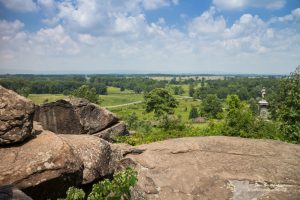
View from Little Round Top looking accross the Valley of Death toward the Wheatfield and Peach Orchard.
Little Round Top Area
Little Round Top represented the left flank of the Union lines, and it was the site of some of the fiercest fighting of the battle. After leaving it only minimally manned when General Sickles placed his forces in poor defensive positions near the Peach Orchard and Wheatfield, heroic efforts on the part of decimated Union forces, most notably the 20th Maine under Colonel Chamberlain saved the flank from being overrun. A trail takes visitors from the parking lot along the edge of Little Round Top which is home to many memorials. Another trail, on the east side of the road, takes visitors to the site of the 20th Maine’s stand on Day 2 which repelled the Confederates. Both trails are short and fairly easy, but budget at least 15-30 minutes for each trail.
To the west of Little Round Top lies Devil’s Den and the area known as the Valley of Death. These areas are full of massive boulders, and a quick visit gives visitors an appreciation for the rugged terrain this part of the battle was fought in.
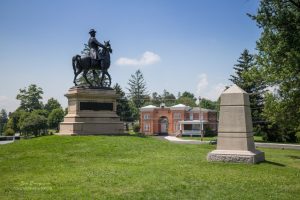
Cemetery Hill is full of memorials to the Union defenders. The gatehouse for the cememtery in the background served as the headquarters for the defending forces in this area.
Cemetery Hill Area
Cemetery Hill and nearby Culps Hill constituted the right flank of the Union’s defense. On Day 1, Confederate General Ewell decided not to secure these key hills even though he probably could have easily overwhelmed the weak defenses. By Day 2, the Union had shored up its defenses, and these hills, entrenched with Union troops and artillery, were the site of fighting on the night of Day 2 and the morning of Day 3, but the Union’s defenses held. A road takes visitors along Rock Creek at the bottom of these hills and up onto the top of Culps Hill. Parking at the nearby Evergreen Cemetery and Soldier’s National Cemetery offers access to the defenses and numerous memorials atop the low Cemetery Hill. 15 minutes would allow a quick drive through to Culps Hill or a quick walk around the monuments on Cemetery Hill. A more thorough exploration or time at the cemetery would probably take between 1 and 2 hours.
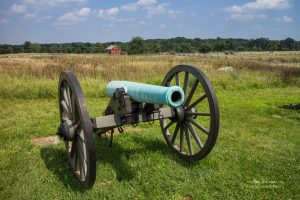
A Napoleon cannon marks the Union defensive line near the Angle where Pickett’s Charge was repelled.
The Angle Area
The Angle represented the center of the Union’s defensive line along Cemetery Ridge south of Gettysburg. It was here on Day 3 of the battle where General Lee threw a good portion of his Confederate forces against the Union defenses. This was where Union defenders stopped Pickett’s Charge where more than 12,000 Confederates left the cover of the woods west of town to run accross more than a mile of open fields into well-prepared defensive positions. All along Hancock Avenue, visitors can see memorials to the defenders, the most prominent of which is the Pennsylvania Memorial. Just north of this memorial is the Angle and the Copse of Trees which marked the furthest point of advance for Pickett’s forces and is considered the high-water mark of the Confederacy. This is a good vantage point to survey just how much open terrain the Confederate forces had to cross and why the Union artillery had the advantage in beating them back. After this failed attack, Lee withdrew his forces, and the Battle of Gettysburg was essentially over.
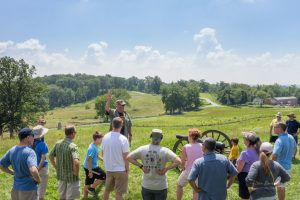
Lecture from our excellent guide at Cemetery Hill with Culps Hill in the background.
General Recommendations This park is very spread out and large. To keep the battle in perspective, I recommend familiarizing yourself a little with the battle beforehand to be able to see the sites in the right order and in their overall context. I highly recommend starting at the Visitors Center to plan your route based on the amount of time you have available. My group was led by a licensed tour guide who also teaches at the National Defense University in Washington, D.C., and his insights and commentary enriched the experience greatly. I highly recommend including an official tour in your plans if you have the time.
While nothing in the park is too far from town, most of the sites don’t have concessions nearby. You will extend your ability to see the battlefield if you’re well prepared with plenty of water, food, sunscreen and insect repellent.
Nearby Towns Gettysburg, York, Hannover and Harrisburg (Pennsylvania), Hagerstown and Baltimore (Maryland)
Other Nearby Attractions Eisenhower National Historic Site
Official NPS Website Gettysburg NMP
- The large and modern Visitors Center at Gettysburg NMP.
- Uniforms on display at the Visitors Center as a volunteer dressed as a Union infantryman explains what it was like to be a soldier during the battle.
- One of several displays of small arms and equipment at the Gettysburg NMP Visitors Center.
- Looking toward the Lutheran Seminary from McPherson’s Ridge where the first fighting of the three-day battle occured.
- Statue to John Burns near the McPherson farm. The 70-year-old Burns, a resident of Gettysburg, brought out his musket and fought alongside Union troops.
- Panorama of the battlefield at Oak Ridge looking from the Confederate position on Oak Hill. The Eternal Light Peace Memorial is on the right.
- Eternal Light Peace Memorial and a small cannon atop Oak Hill overlooking the battlefield at Oak Ridge.
- Union forces retreated through these fields north of Gettysburg on Day 1 of the battle after being overwhelmed at Oak Ridge.
- Panorama of the view from Little Round Top looking over the Valley of Death.
- Monument to General Warren atop Little Round Top.
- Memorial to Col Patty O’Rourke who was killed defending Little Round Top on July 2nd, 1863. It’s said rubbing his nose will bring good luck.
- A volunteer dressed as a Union Brigadier General stands with a cannon on Little Round Top, site of fierce fighting on Day 2 of the battle.
- One of the most desperate moments of the Battle of Gettysburg came on July 2nd when the left of the Union line was held in these woods on Little Round Top by the 20th Maine. Despite heavy losses, Col Chamberlain ordered his troops to fix bayonettes and charge down the hill, stopping the Confederate advance.
- Memorial to the 20th Maine at Little Round Top with the names of those who were killed in the battle.
- View from Little Round Top looking across the Valley of Death toward the Wheatfield and Peach Orchard.
- Cemetery Hill was one of the key pieces of high ground where the Union defenses stood. These cannon overlook Rock Creek where the Confederates advanced and fought on Day 3 of the battle.
- Panorama looking east from the Union position on Cemetery Hill
- Cemetery Hill is full of memorials to the Union defenders. The gatehouse for the cememtery in the background served as the headquarters for the defending forces in this area.
- This is the Women’s Memorial commemorating the role women played in the battle. In the background is Evergreen Cememtery.
- Lecture from our excellent guide at Cemetery Hill with Culps Hill in the background.
- A Napoleon cannon marks the Union defensive line near the Angle where Pickett’s Charge was repelled.
- One memorial near the Angle is this one commemorating the High Water Mark of the Confederacy. This spot near the Copse of Trees is as far as the Confederates got during Pickett’s charge on the last day of the battle. After this, the Conferacy lost ground for the rest of the war.
- This panorama captures the fields across which Pickett’s Charge occured as seen from the Union defenses near the Angle. It’s just over a mile from this spot to the treeline where the charge began. This was the last major action of the Battle of Gettysburg.
Write Your Own Review

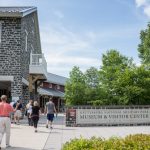
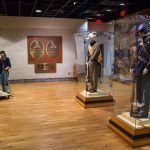
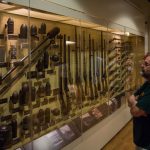
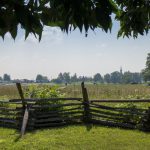
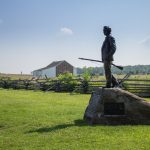
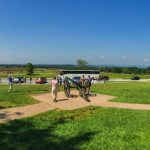
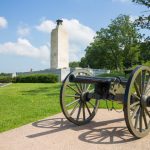
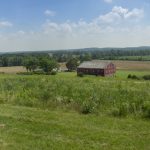
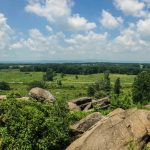
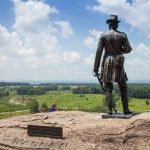
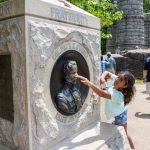
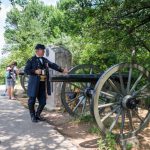
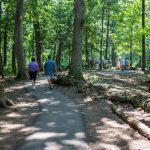
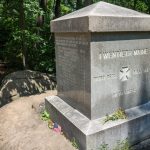
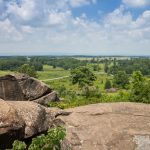
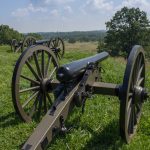
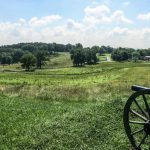

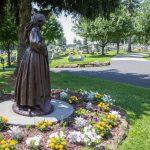
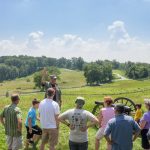
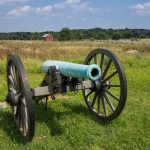
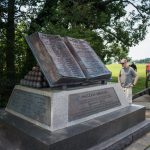
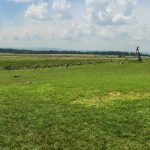
No Comments Yet